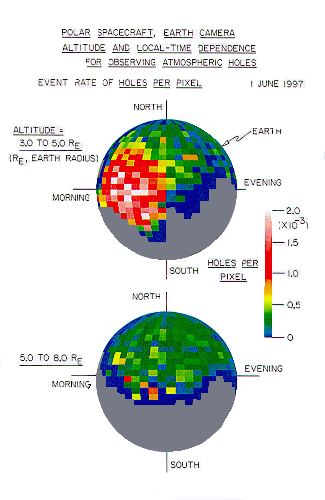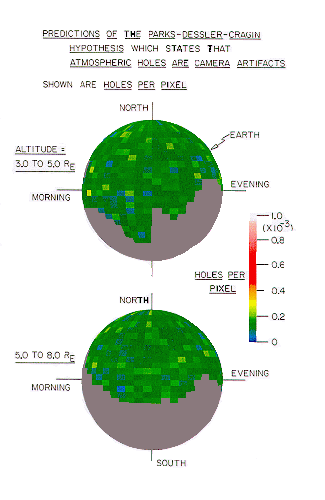Small Comet Images Pass the Ultimate Test,
Proving the Reality of Atmospheric Holes
![]() Physicists Frank and Sigwarth found that the Polar data easily pass the
ultimate test for the reality of the atmospheric holes. This ultimate
test is based on one simple fact: if the atmospheric holes are real, then
the number of holes detected in the images should decrease as the
spacecraft's altitude increases. Why? Because as the satellite's altitude
above the atmosphere increases, the apparent size of the atmospheric
holes its camera sees should decrease, until most of the holes become
just too small to be seen by the camera. On the other hand, if the data
show no decrease in the number of atmospheric holes as the spacecraft's
altitude increases, then the atmospheric holes are an instrumental
artifact. This "altitude test" is generally accepted by the
scientific community as the decisive evidence for or against the reality
of the atmospheric holes.
Physicists Frank and Sigwarth found that the Polar data easily pass the
ultimate test for the reality of the atmospheric holes. This ultimate
test is based on one simple fact: if the atmospheric holes are real, then
the number of holes detected in the images should decrease as the
spacecraft's altitude increases. Why? Because as the satellite's altitude
above the atmosphere increases, the apparent size of the atmospheric
holes its camera sees should decrease, until most of the holes become
just too small to be seen by the camera. On the other hand, if the data
show no decrease in the number of atmospheric holes as the spacecraft's
altitude increases, then the atmospheric holes are an instrumental
artifact. This "altitude test" is generally accepted by the
scientific community as the decisive evidence for or against the reality
of the atmospheric holes.

![]() Using Polar data from June 1, 1997--which are similar to those obtained
on other dates--Frank and Sigwarth compared the low altitude data, when
the Polar spacecraft was between 3 and 5 times the Earth's radius above
the surface, to the high altitude data, when the spacecraft was between 5
and 8 Earth radii above the surface. On the day in question, a total of
5,650 holes appeared in the
Using Polar data from June 1, 1997--which are similar to those obtained
on other dates--Frank and Sigwarth compared the low altitude data, when
the Polar spacecraft was between 3 and 5 times the Earth's radius above
the surface, to the high altitude data, when the spacecraft was between 5
and 8 Earth radii above the surface. On the day in question, a total of
5,650 holes appeared in the
images. For the same area in the images,
the high altitude data showed an 80 percent drop in the frequency of
atmospheric holes in comparison with the low altitude data.
![]() If the holes were an instrumental artifact, then obviously the frequency
of the holes would not be dependent on the spacecraft's altitude and
about the same number of holes should have been seen in the two altitude
ranges. But more than five times as many holes were observed at the lower
altitudes. "This result is a marvelous confirmation of the reality
of atmospheric holes," notes Frank.
If the holes were an instrumental artifact, then obviously the frequency
of the holes would not be dependent on the spacecraft's altitude and
about the same number of holes should have been seen in the two altitude
ranges. But more than five times as many holes were observed at the lower
altitudes. "This result is a marvelous confirmation of the reality
of atmospheric holes," notes Frank.
![]() This ultimate test could not be applied to earlier Dynamics Explorer-1
images because that spacecraft (with an apogee altitude of 23,300 km
versus Polar's 50,510 km apogee) did not get high enough above the
atmosphere for the atmospheric holes to elude detection by its UV camera.
But as with the atmospheric holes found in the Dynamic Explorer-1 images,
those found in the Polar spacecraft's images also show a greater number
of impacts during the morning hours as compared to the evening hours.
This provides yet further confirmation that the holes are indeed real and
not instrumental artifacts. If the holes were an artifact, then their
appearance in the images should not be dependent on the time of day.
This ultimate test could not be applied to earlier Dynamics Explorer-1
images because that spacecraft (with an apogee altitude of 23,300 km
versus Polar's 50,510 km apogee) did not get high enough above the
atmosphere for the atmospheric holes to elude detection by its UV camera.
But as with the atmospheric holes found in the Dynamic Explorer-1 images,
those found in the Polar spacecraft's images also show a greater number
of impacts during the morning hours as compared to the evening hours.
This provides yet further confirmation that the holes are indeed real and
not instrumental artifacts. If the holes were an artifact, then their
appearance in the images should not be dependent on the time of day.

![]() The need for this ultimate test of the reality of atmospheric holes arose
after the presentation of the Polar small comet discoveries by University
of Iowa researchers in May of 1997. Despite all the evidence presented
from Polar proving that the atmospheric holes are indeed a geophysical
phenomenon, many members of the scientific community still refused to
accept the reality of the atmospheric holes, no doubt because of the
immense implications of such large fluxes of small comets in the vicinity
of our planet. These doubters have relied on an alternative hypothesis,
which Frank calls the Parks-Dessler-Cragin Hypothesis--after George
Parks, Alexander Dessler and Bruce Cragin--which holds that the
atmospheric hole phenomenon is an artifact of the UV cameras. But if the
holes were instrument artifacts, then the number of darkened clusters of
pixels in the images should not be affected by the altitude of the
spacecraft.(See comparison chart.)
Since the ultimate test by Frank and Sigwarth shows that the appearance
of atmospheric holes in the images varies significantly by altitude, the
atmospheric holes must be a genuine geophysical phenomenon. "The
scientific community must now proceed toward evaluating their
origins," notes Frank.
The need for this ultimate test of the reality of atmospheric holes arose
after the presentation of the Polar small comet discoveries by University
of Iowa researchers in May of 1997. Despite all the evidence presented
from Polar proving that the atmospheric holes are indeed a geophysical
phenomenon, many members of the scientific community still refused to
accept the reality of the atmospheric holes, no doubt because of the
immense implications of such large fluxes of small comets in the vicinity
of our planet. These doubters have relied on an alternative hypothesis,
which Frank calls the Parks-Dessler-Cragin Hypothesis--after George
Parks, Alexander Dessler and Bruce Cragin--which holds that the
atmospheric hole phenomenon is an artifact of the UV cameras. But if the
holes were instrument artifacts, then the number of darkened clusters of
pixels in the images should not be affected by the altitude of the
spacecraft.(See comparison chart.)
Since the ultimate test by Frank and Sigwarth shows that the appearance
of atmospheric holes in the images varies significantly by altitude, the
atmospheric holes must be a genuine geophysical phenomenon. "The
scientific community must now proceed toward evaluating their
origins," notes Frank.